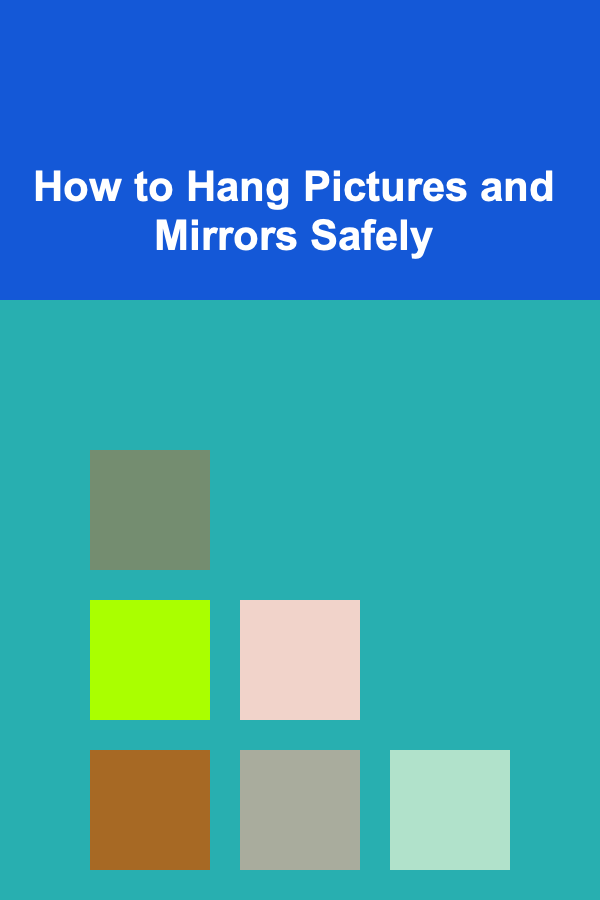
How to Hang Pictures and Mirrors Safely
ebook include PDF & Audio bundle (Micro Guide)
$12.99$10.99
Limited Time Offer! Order within the next:

Hanging pictures and mirrors is a simple yet effective way to decorate and personalize any space. However, if not done correctly, it can lead to damage to your walls or, worse, the risk of injury. Properly hanging pictures and mirrors not only enhances the aesthetic of your room but also ensures that they stay securely in place, making your space both beautiful and safe.
In this article, we will explore the process of safely hanging pictures and mirrors, focusing on tools, techniques, and safety precautions. Whether you're a seasoned DIYer or a first-time decorator, this guide will help you approach the task with confidence and care.
Preparation and Tools You'll Need
Before you start hanging pictures and mirrors, it's essential to gather the right tools and materials. The quality and type of tools used can significantly impact the safety and appearance of your wall decor. Here's what you'll need:
Basic Tools:
- Tape Measure: Accurate measurement is crucial when positioning your pictures or mirrors.
- Pencil or Marker: For marking drill points or hook placements on the wall.
- Level: A level ensures that your picture or mirror hangs straight and balanced.
- Hammer: If you're using nails or picture hooks, a hammer will help secure them in place.
- Screwdriver (if necessary): For any screws or mounts that require a more secure installation.
- Drill (for heavier pieces): A drill is necessary for larger or heavier mirrors and pictures that require screws or wall anchors.
Picture Hanging Hardware:
- Picture Hooks: These are small hooks designed to bear the weight of the picture frame, usually with nails for easy wall penetration.
- Wall Anchors or Toggle Bolts: Wall anchors are used when hanging heavy items or when the picture frame needs more support than a nail can provide. Toggle bolts are especially useful for plaster walls or drywall.
- D-Rings or Sawtooth Hangers: These are typically attached to the back of frames and provide an easy way to hang your art.
Additional Materials:
- Wall Protectors or Felt Pads: These help protect the wall surface and the frame from scratches and dents.
- Stud Finder (for heavy items): To locate wall studs and provide extra support for heavier items like large mirrors.
Once you've gathered all the necessary tools, the next step is assessing the space where you intend to hang your pictures or mirrors.
Assessing the Space
The placement of pictures and mirrors is just as important as the safety measures involved in hanging them. A well-placed item can dramatically improve the look of a room, while improper positioning can result in an unbalanced or uncomfortable atmosphere. Here's how to assess the space:
Consider the Size and Shape of the Wall
The size of the wall you are working with will dictate the size and number of pictures or mirrors you can hang. For larger walls, grouping multiple pieces can create a cohesive look. For smaller walls, you may want to choose one statement piece. When it comes to mirrors, consider the height and width of the mirror in relation to the size of the wall.
Determine the Height for Hanging
As a general rule of thumb, pictures and mirrors should be hung at eye level. The ideal height is typically around 57 to 60 inches from the floor to the center of the artwork. This creates a balanced look for most viewers. However, depending on the furniture or wall features (like a sofa or mantle), you may need to adjust this height.
If you're hanging a mirror above a piece of furniture, the mirror's bottom edge should be around 4 to 6 inches above the furniture.
Consider the Wall Type
Different wall types require different hanging techniques. For example:
- Drywall: The most common material used in modern homes. It's usually safe to hang lightweight to moderate pictures with nails or picture hooks. However, for heavier pieces, you may need wall anchors or screws.
- Plaster Walls: These require more care, as they are prone to cracking. You'll need special hooks or screws, or use a drill to avoid damaging the plaster.
- Brick or Concrete Walls: You will need masonry screws or wall plugs for these surfaces.
- Wooden Walls (or Studs): If you have wooden walls, you can screw directly into the studs for maximum support. A stud finder will help locate the wooden studs behind drywall.
The Hanging Process
Once you've decided where to hang your pictures or mirrors, it's time to move on to the actual process. This involves careful measurements, selecting the right hardware, and following a structured approach.
Step 1: Measure and Mark
Start by measuring the height at which you want to hang your picture or mirror. Use a tape measure to determine the exact placement and mark the points lightly with a pencil or marker. For multiple pictures, use a level to ensure they're evenly spaced and aligned.
Step 2: Determine the Right Hanging Hardware
Choose your hanging hardware based on the weight of the picture or mirror:
- Lightweight Items: For lightweight pieces, picture hooks or nails are often sufficient.
- Moderate to Heavy Items: If your picture or mirror is heavier, use wall anchors, screws, or toggle bolts. Wall anchors are particularly useful for drywall or plaster, while toggle bolts work well for heavier items and materials like plaster or concrete.
- Framed Mirrors: Mirrors are often heavier, so you may need to use multiple points of support, such as a D-ring with wall anchors, or a dedicated mirror hanging system.
Step 3: Install the Hanging Hardware
After determining the correct hardware, install it into the wall at the marked points. If you're using nails or picture hooks, simply hammer them into place. For screws or wall anchors, you may need to drill a hole before securing the hardware.
For D-ring hangers on the back of your frame, measure the distance between the hangers and the top edge of the frame, and then mark those points on the wall.
Step 4: Hang the Picture or Mirror
Once your hardware is securely in place, hang your picture or mirror on the hooks or screws. Double-check the alignment and level of your frame. If you're hanging a large mirror, make sure that it's properly secured and that the hardware can support the weight.
If you're using sawtooth hangers or D-rings, make sure they are aligned correctly on the wall, ensuring the frame is evenly balanced.
Step 5: Adjust and Fine-Tune
Once your piece is hung, step back and assess how it looks from different angles. Make any necessary adjustments to the placement to ensure it's visually appealing and aligned with the rest of your decor. You can use a level to check that the item is perfectly straight.
Special Considerations for Mirrors
Mirrors, especially large ones, require extra caution. Mirrors can be heavy, and improperly secured mirrors pose a significant safety risk. Here's what to keep in mind when hanging mirrors:
Choose Appropriate Hardware for the Mirror's Weight
If you're hanging a mirror that weighs more than 10 pounds, you will need additional support to ensure it remains safely in place. Use heavy-duty picture hooks or D-rings with screws that are designed to hold substantial weight. Toggle bolts are another excellent option for supporting heavier mirrors.
Use a Mirror Hanging Kit
A mirror hanging kit can be a convenient option for ensuring the safety of your mirror. These kits usually come with everything you need, including brackets, screws, and anchors designed specifically for mirrors.
Double Check the Mounting
If you're using a wire to hang the mirror, ensure that it's strong enough to support the mirror's weight. Use two points of attachment on the wall to distribute the weight evenly. This will minimize the risk of one point of failure.
Safety Precautions
When hanging pictures and mirrors, safety should always be a priority. To ensure that the process is safe for both you and your home, here are some key safety tips:
Check the Wall's Integrity
Before installing any hardware, ensure the wall is in good condition. If the wall is cracked, unstable, or deteriorating, the weight of the picture or mirror could cause it to fall. This is especially important when hanging heavy items.
Use the Right Tools
Avoid using tools that are worn out or broken. A hammer with a damaged head, or a drill with a dull bit, can cause accidents or make the process less efficient. Always use the proper tools for the job.
Consider the Location
Avoid hanging heavy mirrors or pictures in areas where they might be bumped into or knocked down. Keep in mind areas where children or pets might come into contact with the items, as they can easily cause damage.
Regular Maintenance
Even after hanging your pictures or mirrors, periodically check their placement to ensure they are still secure. Over time, the hardware might loosen or the item could shift.
Conclusion
Hanging pictures and mirrors is an enjoyable and rewarding task that allows you to personalize and elevate the look of your home. By following the right steps and taking the necessary precautions, you can ensure that your wall decor stays securely in place and enhances your living space.
Always consider the size, weight, and type of wall before choosing the appropriate hanging hardware, and never underestimate the importance of measuring and leveling. Properly securing your pictures and mirrors can make a world of difference in both aesthetics and safety.
With these guidelines in mind, you'll be able to hang pictures and mirrors safely and confidently, creating a beautiful, organized home that you can enjoy for years to come.

Becoming a Successful Procurement Manager: Essential Skills for Optimizing Purchasing Operations
Read More
How to Help Small Businesses with Financial Forecasting
Read More
How to Install a Workbench for DIY Projects
Read More
How to Minimize the Appearance of Dark Spots on Hands
Read More
How to Plan a Dance Class with Limited Space
Read More
10 Tips for a Relationship To-Do List That Prioritizes Quality Time
Read MoreOther Products

Becoming a Successful Procurement Manager: Essential Skills for Optimizing Purchasing Operations
Read More
How to Help Small Businesses with Financial Forecasting
Read More
How to Install a Workbench for DIY Projects
Read More
How to Minimize the Appearance of Dark Spots on Hands
Read More
How to Plan a Dance Class with Limited Space
Read More